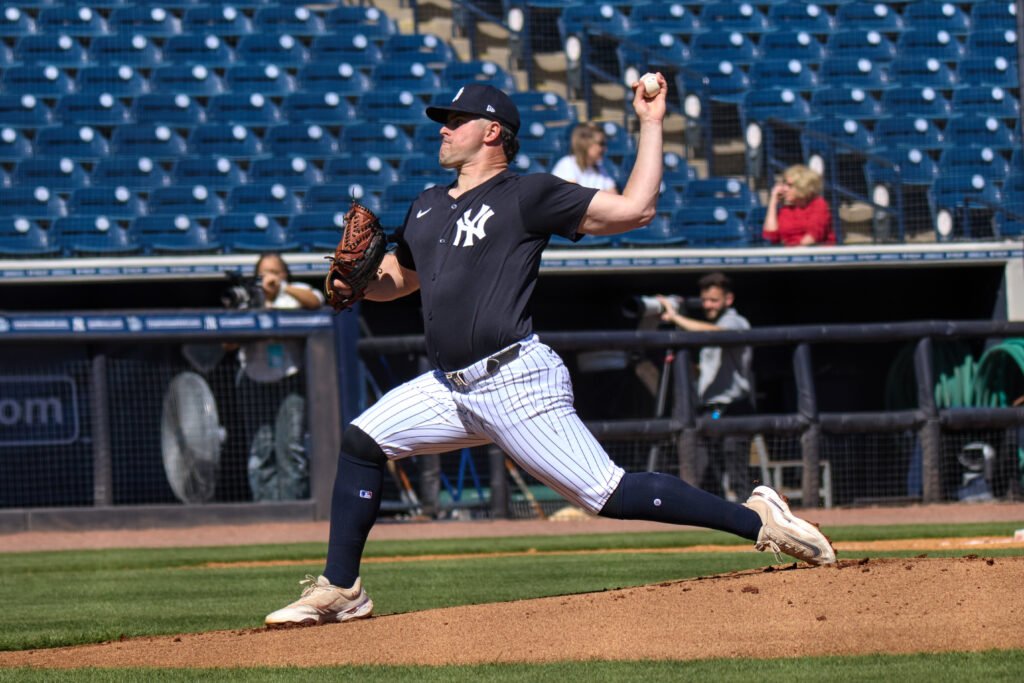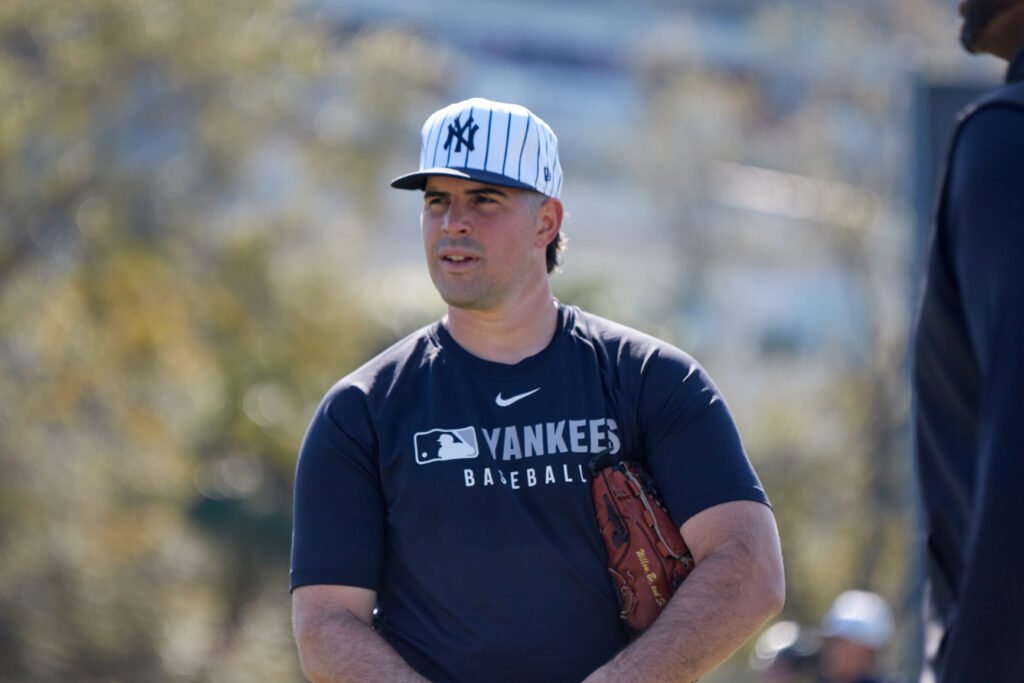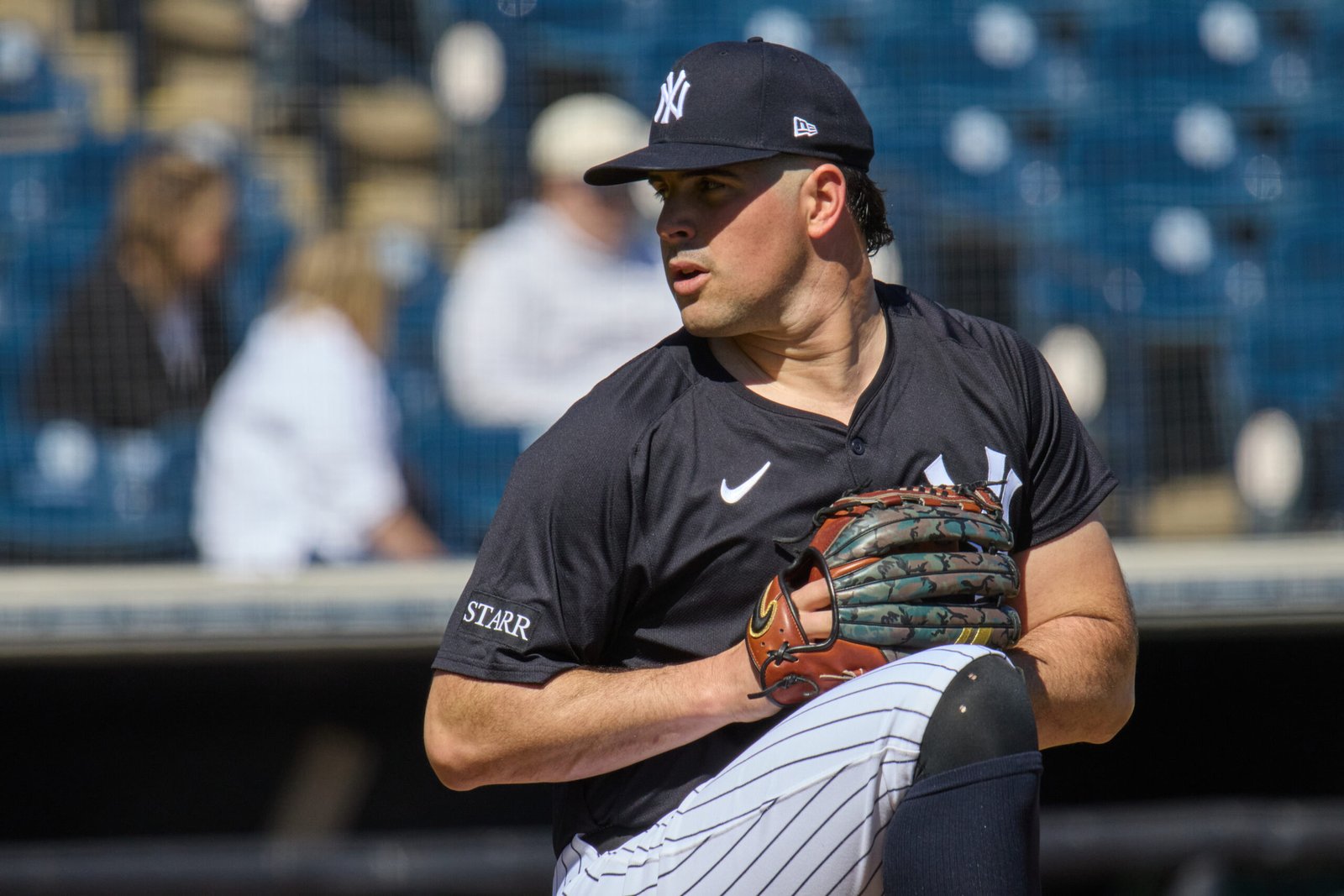Carlos Rodón’s third season in pinstripes has been nothing short of a renaissance. After a disastrous 2023 debut and an up-and-down 2024, the left-hander has reinvented himself in 2025. By overhauling his mechanics, expanding his pitch arsenal, and refining his approach, Rodón is delivering the ace-level performance the Yankees envisioned when they signed him. The in-depth analysis in this article will explore how mechanical tweaks, pitch usage changes, and improved health and mindset have all contributed to Rodón’s 2025 resurgence.
From Disaster to Dominance: 2023–2025 in Numbers
Rodón’s journey to 2025 dominance began in the ashes of a nightmarish 2023. Nagged by injuries and inconsistency, he managed only 14 starts with a bloated 6.85 ERA and negative WAR. In 2024, a healthier Rodón rebounded with 32 starts of solid but unspectacular pitching (16-9, 3.96 ERA). Even so, a spike in home runs (31 homers allowed) and merely average peripherals kept him from true ace status (4.39 FIP). Fast forward to 2025, and Rodón has elevated his game across the board by posting career bests in ERA and strikeouts while recapturing that front-of-rotation form. The table below highlights the stark contrast in key metrics over the last three seasons:
| Season | ERA | FIP | xERA | K% | BB% | HR/9 | WHIP | WAR (fWAR) |
| 2023 | 6.85 | 5.79 | 5.30 | 22.4% | 9.8% | 2.10 | 1.45 | -0.1 |
| 2024 | 3.96 | 4.39 | 4.14 | 26.5% | 7.7% | 1.59 | 1.22 | 1.7 |
| 2025 | 2.60 | 3.10 | 2.83 | 31.7% | 9.2% | 0.99 | 0.94 | 1.6 |
In raw terms, Rodón’s ERA has plummeted from an awful 6.85 in 2023 to a sterling 2.60 so far in 2025, while his fielding-independent metrics (FIP, xERA) tell a similar tale of drastic improvement. His strikeout rate rebounded from a career-low 22.4% in 2023 to an elite 31.7% in 2025. At the same time, he’s managed to limit contact much better, nearly halving his home run rate and WHIP. In short, virtually every performance indicator shows Rodón transforming from 2023’s disaster into a 2025 success story. The question is: how did he do it? The answers lie in a series of adjustments, both physical and philosophical.
Mechanical Tweaks
Rodón’s more subtle but important changes in 2025 is a smoothing out his arm path to improve consistency with Yankees pitching coach. As one analysis noted, he made a correction so that even when he “misses” with a pitch, the miss is in a safer spot due to a more aligned arm slot. By staying closed longer and keeping his release on a line, Rodón is mitigating those glove-side misses that used to turn into homeruns. The improved mechanics are evident in his finish as well, landing in a stronger fielding position and is balanced on follow-through, meaning that he is maintaining direction better through each pitch.
The net effect of these mechanical tweaks is twofold: Rodón’s fastball is playing up despite a minor velocity dip (more on that below) because his command has sharpened just enough to avoid the big mistake pitches. Even when he doesn’t have pinpoint control, his delivery adjustments mean fewer pitches leak back over the middle. All told, a healthier, more mechanically sound Rodón is attacking hitters with added confidence in 2025.
Reinventing His Pitch Arsenal: New Sinker, Fewer Four-Seamers
Perhaps the most striking change is how Rodón has evolved his pitch repertoire and usage. During his prime years in Chicago and San Francisco, Rodón was essentially a two-pitch power pitcher with a high-90s four-seam fastball and a sweeping slider. By 2023–24, however, that fastball-centric approach had become counterproductive. Hitters sitting dead-red on his heater punished mistakes, hence the 31 HR allowed in 2024, and even his elite slider was less effective when they could eliminate other pitches. The Yankees recognized this and challenged Rodón to expand his arsenal. In 2025, he has done exactly that, emerging as a far more diverse pitcher.
Pitch usage data illustrates the transformation. In 2024, Rodón threw his four-seam fastball about 49% of the time, by far his most-used pitch. He also experimented with a cutter (3.5% usage) as a tertiary pitch to complement his 26% sliders and 12.9% changeups. Fast forward to 2025: Rodón has dramatically reduced his four-seam usage to just 41% and eliminated the cutter entirely. In its place, he has introduced a brand-new sinker that he now throws ~8% of the time. Meanwhile, he’s bumped his changeup usage from about 12–13% up to 16%, and kept a healthy dose of breaking balls (his signature slider ~28% and a curveball ~7%). The table below summarizes Rodón’s pitch mix in 2024 vs 2025:
| Pitch | Usage 2024 | Usage 2025 | Avg Velocity 2024 → 2025 |
| Four-seam FB | 49.4% | 41.2% | 95.4 mph → 94.4 mph |
| Sinker | 0% | 7.9% | 92.2 mph (‘25) |
| Cutter | 3.5% | 0% | 91.8 mph (’24) |
| Slider | 25.9% | 28.1% | 86.8 mph → 85.6 mph |
| Curveball | 8.3% | 6.6% | 81.1 mph → 80.0 mph |
| Changeup | 12.9% | 16.2% | 85.5 mph → 85.3 mph |
The reduction in four-seam fastballs is eye-opening. Right out of the gate in his Opening Day 2025 start, he used the four-seamer under 30% of the time, mixing five different pitches at least 9 times each. This was practically unheard of for Rodón, who hadn’t shown such a varied repertoire since his early career. It’s a clear sign of maturity, humility, and adaptability.
The new sinker deserves special mention. Developed in Tampa, FL on the backfields during spring training, Rodón’s new pitch is designed to give hitters a different look. Unlike a traditional sinker that relies on pronation and pure downward bite, his leverages seam-shifted wake to create a late sink with a high arm slot. Rodón had dabbled with sinkers years ago but ditched them due to inconsistent feel but now he has brought it back with a vengeance. In that first start, he threw 10 sinkers, getting 5 strikes (including 3 called strikes and a whiff) and inducing weak contact with the others. The result? a 61.5% ground-ball rate, Rodón’s highest in nearly 6 years. The new pitch gives him a grounder-inducing weapon to use when he’s ahead in counts or wants a quick out. While the sinker hasn’t increased his strikeout rate, it has induced a ton of weak groundballs at a rate of 46.7%, in comparison to 30.6% with the four-seam fastball. In other words, Rodón can still be a strikeout pitcher and get ground-ball outs when needed. A key cog and lethal combination that has resulted in a 2025 renaissance for the southpaw.
It’s also worth noting Rodón’s changeup evolution. In 2024 he began to trust his changeup more, and by run value it was actually his most effective offering that season (with his highest whiff% among pitches). Post-All-Star break (ASB) 2024, he leaned on the changeup heavily and posted a sub-3.00 ERA with a 30% K% in that stretch. Now in 2025, while the changeup has been hit hard occasionally (some early-season homers came off hanging changeups), he’s maintained it as a crucial part of his mix for right-handed batters. The increased usage (16%) and solid ~35% whiff rate on the change give hitters another off-speed look beyond the slider.
Speaking of the slider, it remains Rodón’s bread-and-butter put-away pitch. His slider usage has stayed around 26–28%, and it generates by far the most whiffs (44% whiff rate) of any pitch in his arsenal. This season he’s using the slider in all counts, not just as a chase pitch when ahead. By sequencing more unpredictably, Rodón has kept hitters from sitting on his four-seamer in fastball counts. Yankees catcher J.C. Escarra noted that in a late-May start, “we wanted them to put the ball in play…we try to chase those punchouts, but when they’re not there, we’re getting outs.” That quote captures the new approach: Rodón will still hunt strikeouts aggressively, but he’s willing to use the sinker or a well-placed slider to get soft contact early in the count if the swing-and-miss isn’t there. It’s smart, efficient pitching.
The numbers underscore how this diversified arsenal has paid off. Hitters can no longer zero in on a single pitch or velocity. Rodón’s fastball usage drop is paired with a slight dip in velocity (from 95.4 mph in 2024 to 94.3 mph in 2025), but that hasn’t hurt him. If anything, the lower velocity might be intentional, allowing for better command and separation from his off-speed offerings. His slider and curve are each about one mph slower as well, possibly reflecting a focus on movement and location over sheer power. Meanwhile, the introduction of the 92 mph sinker and the continued confidence in the mid-80s changeup have given Rodón a five-pitch repertoire that he can tailor to each situation.

Velocity, Spin, and Movement: Statcast Trends
A quick look under the Statcast hood reveals further nuances in Rodón’s 2025 improvement. While he isn’t lighting up the radar gun quite like he did in 2021–22, Rodón’s stuff remains electric. His four-seam fastball averages 94.3 mph this year, down about one mph from the 95–96 range of his peak, but still above league average. Interestingly, the Statcast extension gains mentioned earlier help offset this slight velocity loss. By releasing the ball closer to the plate, the perceived velocity and effective rise on his fastball remain strong. In fact, Rodón’s fastball “ride” (induced vertical break) and spin rate are still high-ranking; his fastball spin is around the 60th–65th percentile in 2025, similar to last year’s percentile, indicating he hasn’t lost the raw spin on his heater.
Rodón’s whiff and chase rates highlight the improvement in his nastiness. In 2023, he induced whiffs on roughly 26% of swings, a middling rate for a power pitcher. That jumped to 30% in 2024 and is up to 32.8% in 2025, placing him in the 89th percentile of MLB in swing-and-miss rate. His chase rate (31.1%) is also above league average, reflecting how his improved sequencing gets hitters to expand the zone. In simpler terms, batters are missing more often against Rodón this year, and often they’re swinging at his pitches on his terms. A lot of that is due to the slider and changeup doing their jobs as wipeout offerings, with the fastball playing a supporting role in setting them up.
Crucially, when hitters do make contact, it’s been much weaker contact than in prior years. Statcast’s expected stats paint a clear picture: Rodón’s expected wOBA (xwOBA) allowed is down to .276 in 2025, a big improvement from a slightly above average .311 xwOBA in 2024. His percentile ranking in expected ERA (xERA) shot up from the 42nd percentile in 2024 to the 84th percentile in 2025. In tangible terms, his Statcast expected ERA is around 3.00 this season, compared to 4.00+ a year ago. That aligns with the massive drop in hard contact against him. Rodón’s Hard-Hit% (balls hit 95+ mph) allowed is 38.7% this year, a noticeable decline from 41.8% in 2023. His Barrel rate (percentage of balls that are hit in the ideal contact point on a hitters bat) – has been cut roughly in half. In 2024, he was in just the 4th percentile for Barrel%, meaning among the worst in the league at allowing barreled contact (no surprise given his home run issues. In 2025, he’s around the 58th percentile in Barrel%, an average-or-better performance that reflects far fewer hangers and mistake pitches. By keeping hitters off balance and inducing poorer contact (lots of grounders and topped balls thanks to that sinker), Rodón has dramatically lowered the damage done against him. His Statcast expected slugging (xSLG) allowed has dropped into the top 20% of the league which is additional metric stating how much harder it is to square him up now.
Another subtle factor is pitch efficiency and sequencing leading to better counts. Rodón is often getting ahead of hitters despite throwing fewer fastballs. His first-pitch strike rate (61.6% in 2025) is a slight tick above his career average, and his zone% has actually dropped a bit (44.7% of pitches in the zone). That counterintuitive combo suggests he’s skillfully nibbling just off the plate when needed, then attacking the zone when hitters are on the defensive. The increase in chase rate supports this – he’s getting hitters to offer at pitcher’s pitches. All of this has allowed him to go deeper into games with reasonable pitch counts. After averaging under 5 innings per start in 2023, he averaged about 5.5 IP in 2024, and in 2025 he’s routinely working 6+ innings a start (over 6.0 IP per start through May). Fewer prolonged at-bats and fewer balls launched into the bleachers mean Rodón is completing six and even seven innings more often, a huge boost to his value.
Health and Conditioning: Bouncing Back Strong
Rodón’s resurgence is also a story of health regained. The lefty’s injury-plagued 2023 saw him start the year on the IL (forearm strain), then miss more time midseason with back and hamstring issues. Those physical setbacks not only limited his innings (64.1 IP) but likely affected his mechanics and consistency when he did pitch. By his own admission, Rodón never found his rhythm that year, and his results suffered accordingly.
In 2024, Rodón stayed healthy enough to make 32 starts, and the difference in his stuff was evident. He regained the mid-90s velocity and sharp slider that were his trademarks, suggesting his arm strength fully returned. However, there were whispers that his back injury could be a chronic concern, and indeed he went through a dead-arm period or minor back flare-up that contributed to an ugly stretch before the ASB. The Yankees managed his workload and between-start routines carefully, and post-break he looked refreshed and much more effective (3.34 ERA in 97 IP after the 2024 ASB).
This past offseason, Rodón focused on strengthening his core and lower back to mitigate those issues. While specifics of his conditioning program aren’t public, the results are apparent on the mound as he’s maintaining his velocity deeper into games and hasn’t had any physical setbacks through the first half of 2025. The Yankees even held him out of early spring training games in 2025, preferring controlled bullpen sessions and “lab” work on his new pitches rather than exposing him to unnecessary wear and tear in Grapefruit League action. An approach seems to have paid off, as a fresh Rodón aside from the normal bumps and bruises every pitcher endures, has been in excellent shape.
The improved fitness is evident in how he’s finishing games. In late May, manager Aaron Boone praised Rodón for consistently “showing up, getting on the mound and keep posting” a reference to the team’s mantra of “chopping wood” every day. Rodón himself said his goal is simply “to go out there and get as many outs as I can – keep your head down and keep going.” This workmanlike mindset reflects a pitcher who trusts his body and conditioning; he’s not holding back or fearing an injury with each pitch. Instead, he’s embracing a durable, innings-eater mentality. After a 105-pitch, 6-inning effort against Texas, Rodón bounded off the mound full of energy, a stark contrast to the labored, grimacing exits we saw in 2023. That stamina and confidence in his health have allowed him to focus purely on execution and strategy rather than pain management or mechanics compensation.

Mindset and Mound Presence: A New, Composed Pitcher
The final piece of Rodón’s transformation is his mental approach and mound presence. In 2023, frustration often boiled over as he had visible spats of anger and even sarcasm toward booing fans as he struggled. Fast forward to the present day, he exudes a very different aura on the hill. Rodón has adopted a calmer, more methodical mindset, summed up by that “chopping wood” mantra. Every start is just another tree to fall. He goes out, sticks to the game plan, and grinds. This even-keeled approach has helped him weather adversity. For example, he began 2025 with a few clunky starts (a 1-3 record and 5.48 ERA through four outings). Instead of spiraling, Rodón remained process-focused and quickly turned the corner. In his own words, he wasn’t worried about the rough beginning because he felt he was “dominant” and just needed to execute a bit better. That resilience paid off. In his next seven starts, the former North Carolina State Ace went 5–0 with a 1.47 ERA, restoring his confidence and the team’s trust in him.
On the mound, Rodón now displays the swagger of an ace. He works with quicker pace and purpose, a sign of conviction in his pitches. Notably, he has developed a strong rapport with his catchers, often not shaking off at all during games. In a recent outing, catcher J.C. Escarra noted “I don’t think he shook off one pitch; he trusted me calling the whole game”, which allowed them to keep hitters guessing and off-balance. This trust in his batterymate is a maturity leap, as Rodón is no longer stubbornly trying to overpower everyone with what he thinks is best. He’s willing to pitch to scouting reports and adapt on the fly with guidance from behind the plate. The result is a more efficient attack and a pitcher in total control of the flow of the game.
Even Rodón’s body language radiates confidence. When he gets a big strikeout to end an inning now, he’ll stroll off with a fired-up, chest-out strut, a celebration that Yankees fans love to see. It’s the look of a pitcher who knows he’s got the upper hand. That presence has an effect beyond aesthetics: it fires up his teammates and perhaps intimidates opponents a bit. Rodón is pitching with the swagger of an ace, and it’s infectious. As an MLB.com game recap put it, “Rodón walked two and struck out eight, bounding off the mound barrel-chested after his 105th pitch… generated an inning-ending whiff”, while his catcher emphatically pointed at him as if to say “You’re the man.” This is a very different picture than a year or two ago.
Another aspect of his mental game is patience and strategic mindset. In the past, if Rodón’s fastball was getting hit, he might stubbornly try to throw it harder and harder, often to his detriment. Now in 2025, rather than pressing when something isn’t working, Rodón makes in-game adjustments. For instance, after giving up a couple of lasers on four-seamers early in one start, he consciously pivoted away from the heater by throwing only 8 more four-seamers the rest of that game and leaning on breaking balls and the sinker to great success. The new ‘Los instead “adjusted” mid-game and trusted his expanded arsenal to carry him through. That kind of real-time adaptability is the hallmark of a mature pitcher.
Lastly, the mental shift is evident in how Rodón talks about his goals. Gone are mentions of strikeout titles or being the savior of the staff; he speaks in terms of team wins and consistency. He knows with Gerrit Cole out for the season and other Yankees starters injured, he has to be the workhorse behind the newly acquired Max Fried. Rather than shrink from that, Rodón has embraced the “best supporting player” role by becoming the reliable No. 2 the Yankees desperately need. As of Memorial Day 2025, Bob Nightengale even named Rodón MLB’s best “sidekick” of the season, noting that he had quietly gone 6–2 with a 2.88 ERA in 11 starts, including a 5–0, 1.48 ERA tear in his last five outings. That recognition speaks to Rodón’s consistency and impact. In those games, he held batters to a .160 average, which illustrates how locked-in he has been. Rodón himself isn’t caught up in the accolades, he’s focused on “showing up with grit and tenacity” each day. But there’s no denying that his renewed mental focus has elevated him into the ace-caliber pitcher the Yankees signed up for.
Conclusion: The Making of a Yankees Ace
Carlos Rodón’s 2025 season has been a masterclass in adaptation. By ironing out his mechanics, broadening his pitch repertoire, leveraging data and coaching, and maintaining a bulldog mindset, Rodón has turned the page on his early Yankee struggles. The statistical turnaround from 2023’s fiasco to 2025’s ace-level performance is dramatic and is grounded in the concrete adjustments detailed above. He’s gone from a two-pitch thrower with diminishing returns, to a thinking-man’s pitcher with five weapons in his holster. As a result, hitters are often left flailing at sliders and changeups, or beating his sinkers into the ground for routine outs.
The advanced metrics validate Rodón’s resurgence: a sub-3 ERA backed by a sub-3 FIP, elite strikeout and whiff rates, greatly reduced hard contact, and a WAR that’s climbing with each quality start. Just as importantly, Rodón is finally delivering value on the mound commensurate with his $162 million contract, stabilizing a Yankees rotation beset by injuries. “It’s about time,” manager Aaron Boone quipped in May, seeing Rodón blossom into the co-ace he was signed to be.
The Yankees are reaping the rewards. If he keeps chopping wood and refining his craft, Carlos Rodón may yet fulfill the lofty expectations and become, as one writer put it, not just a sidekick but a “defining force” for this Yankees team. For now, his 2025 transformation stands as one of the most compelling pitching turnarounds in baseball, a case study in how adjustments both big and small can unlock a player’s full potential.



No responses yet
Get the book that is perfect for a weekend binge. The Project Hail Mary PDF is hard to put down. This digital version is great for marathon reading. You will want to finish it in one sitting. https://projecthailmarypdf.top/ books like project hail mary